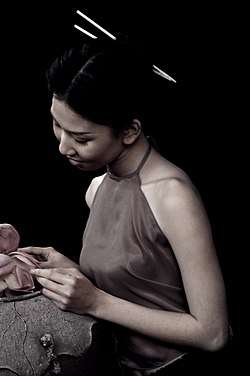Yếm
A yếm (Vietnamese: [ʔiə̌m]) is a traditional Vietnamese bodice used primarily as an undergarment that was once worn by Vietnamese women across all classes. There exists a modern variant called the áo yếm, but the historical garment was simply called a yếm. It was most usually worn underneath a blouse or overcoat, for modesty's sake.

It is a simple garment with many variations from its basic form, which is a simple, usually diamond or square-cut piece of cloth draped over a woman's chest with strings to tie at the neck and back.
History
The yếm originated from the Chinese dudou, a variant of similar undergarments used in China since antiquity whose use spread under the Ming and Qing dynasties. It became popular in northern Vietnam. Unlike other Vietnamese clothing that helped to segregate the classes, the unseen yếm were worn as an undergarment by Vietnamese women of all walks of life, from peasant women toiling in the fields to imperial consorts. It is an integral part of the áo tứ thân costume, which it is often worn underneath.
The skirt which is worn with the yếm is called váy đụp.[1][2][3][4]
Chinese-style clothing which was forced on Vietnamese people by the Nguyễn dynasty took the place of the yếm and skirt (váy đụp).[5][6][7][8][9][10] Trousers have been adopted by White Hmong.[11] The trousers replaced the traditional skirts of the females of the White Hmong.[12] The tunics and trouser clothing of the Han Chinese on the Ming tradition was worn by the Vietnamese. The áo dài was created when tucks, which were close fitting and compact, were added in the 1920s to this Chinese style.[13] Trousers and tunics on the Chinese pattern in 1774 were ordered by Nguyễn Phúc Khoát to replace the sarong-like traditional clothing.[14]
Chinese clothing in the form of trousers and tunic were mandated by the Vietnamese Nguyễn government. As late as the 1920s in Vietnam's north area in isolated hamlets skirts were still worn.[15] Chinese Ming-, Tang-, and Han-style clothing was ordered to be adopted by Vietnamese military and bureaucrats by the Nguyễn lord Nguyễn Phúc Khoát.[16] Pants were mandated by the Nguyễn in 1744 and the cheongsam inspired the áo dài.[17] Chinese clothing started influencing Vietnamese dress during the Lý dynasty. The current áo dài was introduced by the Nguyễn Lords.[18]
Different types

While it was worn across classes, the material and colors used to make yếm varied widely based upon the person's social status and the occasion. Commoner women usually wore yếm in simple blacks and whites for day to day use, whereas during special occasions they could opt for more festive, brighter colors such as red and pink. Indeed, much of Vietnamese poetry has been dedicated to the beauty of women in their vermilion bodices (yếm đào).
While the bottom of the yếm are v-shaped, there were different styles for the top of the garment which covered the neck, the most common two variations being the rounded neck or the v-shaped neck style.
Some types of yếm have a little pocket within, where women often used to store a little musk or perfume.
In modern Vietnam
As Westernization reached Vietnam, by the 20th century women increasingly abandoned yếm for the Western bra.
Fashion designers, in their constant quest to revitalize interest in traditional costumes - as well as reinvent them - have created many new collections of yếm. The modernized form of the garment is slightly different and is called "áo yếm" rather than "yếm", the latter referring to the historical garment. Áo yếm has proven to be quite popular with young women, perhaps due to its similarity to the Western halterneck.
See also
References
- Elizabeth J. Lewandowski (24 October 2011). The Complete Costume Dictionary. Scarecrow Press. pp. 308–. ISBN 978-0-8108-7785-6.
- Phan Giuong (14 July 2015). Tuttle Concise Vietnamese Dictionary: Vietnamese-English English-Vietnamese. Tuttle Publishing. pp. 364–. ISBN 978-1-4629-1417-3.
- Huffman, Franklin E.; Trà̂n, Trọng Hải (1980). Intermediate Spoken Vietnamese. SEAP Publications. p. 393. ISBN 978-0-87727-500-8.
- Benjamin Wilkinson; Giuong Van Phan (15 March 2003). Periplus Pocket Vietnamese Dictionary: ペリプラスポケットベトナム語辞典. Tuttle Publishing. pp. 81–. ISBN 978-0-7946-0044-0.
- Woodside, Alexander (1988). Vietnam and the Chinese Model: A Comparative Study of Vietnamese and Chinese Government in the First Half of the Nineteenth Century. Harvard Univ Asia Center. p. 134. ISBN 978-0-674-93721-5.
- Globalization: A View by Vietnamese Consumers Through Wedding Windows. ProQuest. 2008. pp. 34–. ISBN 978-0-549-68091-8.
- "Ao dai – Vietnam's national dress - Clothing and Fashion". angelasancartier.net. Retrieved 25 August 2017.
- Nguyen, Ashley (14 March 2010). "#18 Transcultural Tradition of the Vietnamese Ao Dai". Retrieved 25 August 2017.
- "Ao Dai". Retrieved 25 August 2017.
- "The Ao Dai and I: A Personal Essay on Cultural Identity and Steampunk". Tor.com. 20 October 2010. Retrieved 25 August 2017.
- Vietnam. Michelin Travel Publications. 2002. p. 200.
- Gary Yia Lee; Nicholas Tapp (16 September 2010). Culture and Customs of the Hmong. ABC-CLIO. pp. 138–. ISBN 978-0-313-34527-2.
- Anthony Reid (2 June 2015). A History of Southeast Asia: Critical Crossroads. John Wiley & Sons. pp. 285–. ISBN 978-0-631-17961-0.
- Reid, Anthony (1988). Southeast Asia in the Age of Commerce, 1450-1680: The lands below the winds. Yale University Press. p. 90. ISBN 978-0-300-04750-9.
- Rambo, A. Terry (2005). Searching for Vietnam: Selected Writings on Vietnamese Culture and Society. Kyoto University Press. p. 64. ISBN 978-1-920901-05-9.
- Dutton, George; Werner, Jayne; Whitmore, John K. (2012). Sources of Vietnamese Tradition. Columbia University Press. p. 295. ISBN 978-0-231-51110-0.
- "Vietnam Traditional Dress, Ao Dai". www.vietnamonline.com. Retrieved May 20, 2019.
- "Vietnamese Ao Dai: From Dong Son bronze drum to int'l beauty contests". VietNam Breaking News. Feb 28, 2016. Retrieved May 20, 2019.
External links
| Wikimedia Commons has media related to Yếm. |
